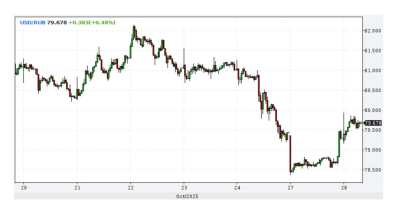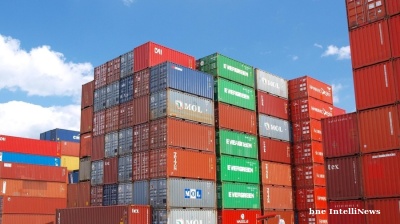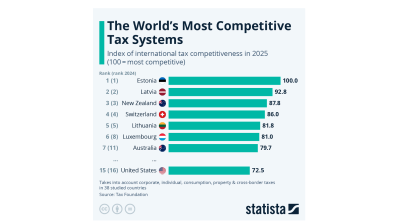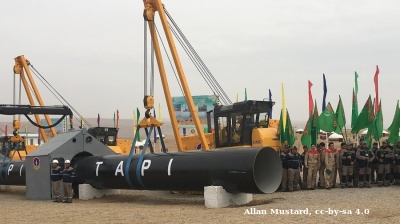The Kazakh national currency, the Kazakhstani tenge (KZT), has depreciated sharply against the greenback over the past two months. It’s hit multiple new lows, falling to KZT 550 to the dollar in late July, before stabilising slightly in early August.
The slight stabilisation is still keeping the tenge at around KZT 540 across the country's currency exchange offices, a figure that is much lower than the previous de facto ceiling of approximately KZT 530 seen in the first half of 2025.
While speculation has often been blamed for currency volatility in Kazakhstan, financial analysts and central bank officials now point to a mix of fundamental economic pressures driving the KZT’s slide, including a swelling trade imbalance, surging import demand, declining oil-related revenues and rising domestic inflation.
Trade imbalance and import demand
Kazakhstan’s trade surplus has narrowed considerably in recent months.
Local economist Yernar Serik was quoted by The Times of Central Asia as saying that the country’s exports fell by 9% y/y to $29.8bn over the January-May period, while imports rose to $23.7bn, leading to a drop in the trade surplus from $9.5bn to $6.0bn.
Driving much of the pressure felt has been an import boom linked to state-sponsored infrastructure programmes. Machinery and equipment imports surged by 47% in June alone, reaching approximately $1.2bn.
Economist Ruslan Sultanov, cited by Zakon.kz, attributed this spike to the ongoing public investment projects. The import of foreign equipment rose from roughly KZT 260bn in February to KZT 651bn in June, possibly reflecting genuine demand rather than speculative flows, Zakon.kz reported.
Inflation is compounding the pressures. Kazakhstan’s annual inflation reached 11.8% in June, a rate that is among the highest in the region. Financial consultant Rasul Rysmambetov suggested that accelerating inflation, combined with a rapid increase in money supply and cash circulation, is creating structural incentives for currency conversion and import-led consumption, Zakon.kz’s report said.
However, not all Kazakh analysts agree that fundamental economic pressures are the driving force behind the tenge depreciation.
Financial analyst Andrey Chebotarev of the Association of Financiers of Kazakhstan told Zakon.kz that a notable increase in speculative activity has taken place in late July, denying fundamental economic reasons.
"This weakening of the tenge has no fundamental economic reasons — it is a matter of speculation,” he said.
At the same time, he noted that growing pressure on the exchange rate increases inflation risks due to rising import prices.
The Association of Financiers attributed the volatility of the tenge in part to remarks made by Prime Minister Olzhas Bektenov during a July 15 press conference. Bektenov announced that the government planned to revise its base forecast for the USD/KZT exchange rate in 2026 from KZT 475 to KZT 540, which would represent a 13.7% increase.
Officials at the National Bank of Kazakhstan (NBK) have sought to downplay suggestions that the tenge’s depreciation is the result of a speculative attack.
The central bank’s view
In late July, NBK Deputy Governor Aliya Moldabekova was quoted as saying by The Astana Times as saying that “fundamentally, there is no justification for a weakening of the tenge. Oil prices remain high, the US dollar is weakening globally, and there are no external shocks. The tenge appears undervalued.”
She highlighted several factors contributing to the current pressure on the exchange rate, including higher government spending, companies converting funds into FX to pay dividends and seasonal tourism.
“These are natural, temporary movements reflecting the market. There is no sign of speculative activity,” Moldabekova reportedly noted.
Central bank governor Timur Suleimenov echoed that view, noting that fiscal injections into the economy have risen nearly 18% y/y, The Astana Times reported. He argued that the combination of high state spending and flat GDP growth has created a situation where domestic demand outpaces the tenge's supply-side fundamentals. Both officials attributed the weakening to structural and seasonal market forces rather than manipulation or panic.
Similar views were expressed by Kazakh financial analyst Almat Orakbay of AFK Capital.
"A key role in the weakening of the tenge during the specified period may have been played by domestic factors. Among them are active utilisation of budget funds, growth in import payments, an increase in foreign currency payments on external debt, the holiday season, as well as purchases for the purposes of the Unified Accumulative Pension Fund [UAPF]," he was quoted as saying in another report by Zakon.kz.
Despite denying speculative activity, the central bank intervened in late July to stabilise the currency, selling foreign reserves after the tenge crossed the "psychological" KZT 550 per dollar threshold on the Kazakhstan Stock Exchange (KASE). Analysts believe the NBK will continue to defend the currency within a soft band, while avoiding heavy-handed interventions that might spook investors or contradict the country’s inflation-targeting regime.
Oil prices below budget assumptions
Although oil prices have recovered somewhat since spring, they remain below Kazakhstan’s fiscal assumptions. The national budget for 2025 was based on Brent crude averaging around $75 per barrel. However, in April–May, oil fell below $60, and as of late July hovered between $68–$70.
Analyst Oljas Baydildinov forecast in April that this slump would put downward pressure on the tenge by mid-summer.
Sultanov told Zakon.kz that the equilibrium rate for the tenge in July should have been closer to KZT 542 against the dollar given current oil prices.
Spillovers from Russia
Beyond macroeconomic variables, regional geopolitical developments may be amplifying uncertainty. Some analysts have noted that ongoing tensions surrounding Russia’s war in Ukraine, including potential new sanctions on Russian oil exports, could put additional strain on the ruble – and by extension, the tenge, given the close economic ties between the two countries.
While Kazakhstan is not directly subject to sanctions, secondary effects via reduced transit, investor caution or changes in export routes could weigh on confidence.
The KZT has historically tracked the Russian ruble closely. However, since the start of the Ukraine War, the interrelated nature of the tenge and the ruble has grown increasingly out-of-sync.
As such, while it has generally been possible to predict the trajectory of the tenge based on the historical movements of the ruble, now the Kazakh currency’s dollar exchange rate is far more uncertain.
The general belief among observers in Kazakhstan appears to be that seasonal factors will wear off and the tenge will not continue to depreciate below KZT 550. But economic and fiscal pressures are unlikely to subside any time soon. As such, it is possible that the tenge will not recover and will stabilise below, KZT520 – or even KZT530 – in the near future.
Data

Ruble strengthens as sanctioned oil companies repatriate cash
The Russian ruble strengthened after the Trump administration imposed oil sanctions on Russia’s leading oil companies, extending a rally that began after the Biden administration imposed oil sanctions on Russia in January.

Russia's central bank cuts rates by 50bp to 16.5%
The Central Bank of Russia (CBR) cut rates by 50bp on October 24 to 16.5% in an effort to boost flagging growth despite fears of a revival of inflationary pressure due to an upcoming two percentage point hike in the planned VAT rates.

Ukraine's trade deficit doubles to $42bn putting new pressure on an already strained economy
Ukraine’s trade deficit has doubled to $42bn as exports fall and imports balloon. The balance of payments deficit is starting to turn into a serious problem that could undermine the country’s macroeconomic stability.

BYD surpasses Tesla to become EV market leader – Statista
While Chinese manufacturer BYD already pulled ahead of Tesla in production volume last year, with 1,777,965 battery electric vehicles (BEV) produced in 2024 (4,500 more than Tesla), the American manufacturer remained ahead in sales.




